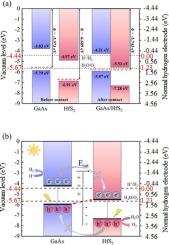一种有前途的直接Z-scheme GaAs/HfS2范德华异质结构光催化剂,用于红外、可见光和紫外太阳光谱的全面水分解
IF 2.4
3区 化学
Q4 CHEMISTRY, PHYSICAL
引用次数: 0
摘要
高太阳能利用率是提高光催化整体水分解中太阳能制氢(STH)能量转换效率的关键问题。然而,几乎占太阳能一半的太阳光谱中的红外光尚未应用于非极性材料。本文沿垂直方向构建了GaAs/HfS2的范德华异质结构,并通过第一性原理计算研究了其结构稳定性、电子性质、光催化水裂解机理、光吸收、STH能量转换效率以及氧化还原反应中的Gibbs自由能变化。分别从结合能、ab-initio分子动力学模拟和声子谱验证了H1型GaAs/HfS2异质结构的热力学、热力学和动力学稳定性。单层GaAs的功函数(5.573 eV)比单层HfS2的功函数(6.689 eV)小,使得电子从GaAs一侧转移到HfS2一侧,从而形成了一个内置电场。在布里温区中心Γ点处,GaAs/HfS2异质结构的直接带隙为0.44 eV,比GaAs和HfS2单层的直接带隙为1.96 eV和1.94 eV小,从而在红外、可见光和紫外光区具有较高的光吸收。ii型能带的排列,特别是具有红外光吸收和高达38.2%的STH效率的直接z型光催化机制,证实了GaAs/HfS2异质结构是一种很有前途的全水分解光催化剂。本文章由计算机程序翻译,如有差异,请以英文原文为准。

A promising direct Z-scheme GaAs/HfS2 van der Waals heterostructure photocatalyst for overall water-splitting using infrared, visible and ultraviolet solar spectrum
High solar energy utilization is a key issue for increasing solar-to‑hydrogen (STH) energy conversion efficiency in photocatalytic overall water-splitting. However, the infrared light of the solar light spectrum, which constitutes almost half of the solar energy, has not been used in non-polar material. Here, the GaAs/HfS2 van der Waals heterostructure has been constructed along the vertical direction and its structural stability, electronic property, photocatalysis water-splitting mechanism, optical absorption, STH energy conversion efficiency, and Gibbs free energy changes in redox reactions have been investigated through first-principles calculation. The thermodynamic, thermal and dynamical stabilities of the GaAs/HfS2 heterostructure with H1 configuration are verified from binding energy, ab-initio molecular dynamics simulation and phonon spectra, respectively. The smaller work function 5.573 eV of the monolayer GaAs than 6.689 eV of the monolayer HfS2 makes 0.149 |e| electron transfer and thus a built-in electric field from GaAs side to HfS2 side. The smaller direct bandgap of 0.44 eV of the GaAs/HfS2 heterostructure than 1.96 eV and 1.94 eV of the GaAs and HfS2 monolayers at central Γ point of the Brillouin zone, resulting in a high optical absorption in infrared, visible and ultraviolet light regions. The type-II band arrangement, especially the direct Z-scheme photocatalysis mechanism with infrared optical absorption and high STH efficiency 38.2 %, conform the GaAs/HfS2 heterostructure is a promising photocatalyst for overall water-splitting.
求助全文
通过发布文献求助,成功后即可免费获取论文全文。
去求助
来源期刊

Chemical Physics
化学-物理:原子、分子和化学物理
CiteScore
4.60
自引率
4.30%
发文量
278
审稿时长
39 days
期刊介绍:
Chemical Physics publishes experimental and theoretical papers on all aspects of chemical physics. In this journal, experiments are related to theory, and in turn theoretical papers are related to present or future experiments. Subjects covered include: spectroscopy and molecular structure, interacting systems, relaxation phenomena, biological systems, materials, fundamental problems in molecular reactivity, molecular quantum theory and statistical mechanics. Computational chemistry studies of routine character are not appropriate for this journal.
 求助内容:
求助内容: 应助结果提醒方式:
应助结果提醒方式:


